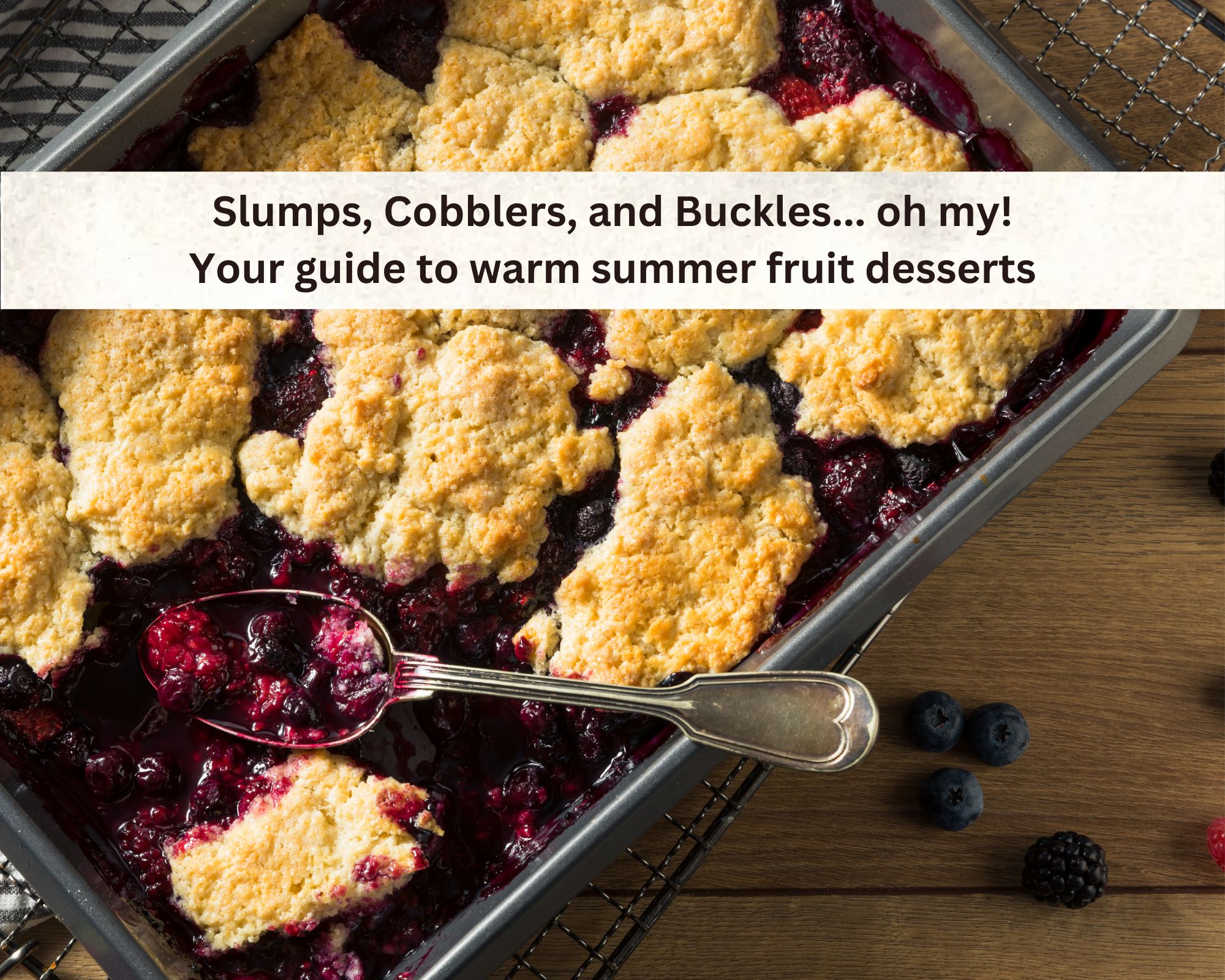It’s nearly that time of year where berries and stone fruits are in abundance. Strawberries kick off the summer in much of the United States, followed by raspberries and blueberries and blackberries. Cherries dot the trees in early to mid-summer, peaches and plums appear at roadside fruit stands by late summer, plus nectarines and apricots, pluots, oh my! All of this has our Kitchen Crew thinking of all the summer desserts we’re itching to prepare from crisps to cobblers, buckles to crumbles, slumps to… sonkers?
There’s a myriad of ways to use summer’s bounty of fruits for baked desserts, and we know the terminology can get confusing. That’s why we’ve come up with this handy guide on what makes each one different and how to go about making them.
CRUMBLE
Arguably the easiest of them all, a crumble is simply a fruit filling baked in a casserole dish or baking pan with a streusel filling on top. Mix flour, butter, sugar, and a touch of salt together with your hands or a food processor and you’re already halfway there. This kind of topping is extra nice with a small amount of spices in it too, like cinnamon, nutmeg, or even cardamom. Any fruit filling will do, from a simple berry compote to cooked down peaches. We especially love combining berries and stone fruit in this one, which combines not just flavor but some textural contrast as well. Try peaches with blackberries, or apricots with raspberries, for starters.
CRISP
Any crisp is a crumble, but not all crumbles are crisps. How does that work? It’s because crisps tend to contain oats, and sometimes nuts, in the topping. Oats and nuts crisp up in the oven when baked with butter and sugar, hence the name. An apple crisp, for example, just wouldn’t be the same without those crispy, dreamy oats on top.
In reality, both terms get used interchangeably these days, and no one will flinch if you call a crisp a crumble. Oats or no oats, both are delicious desserts.
COBBLER
Originally called a cobbler because it resembled cobblestone streets, this dessert consists of a fruit filling baked with biscuits on top. It’s a freeform dessert, meaning the topping doesn’t cover the entirety of the top but rather is applied in dollops, and it’s baked in whatever kind of baking pan you have on hand.
The beauty of a cobbler is that, whereas crumbles and crisps bake into one delicious but dense dessert, here there is a distinct contrast between the flaky, airy biscuit and the softened fruit filling beneath. It’s like eating a strawberry shortcake with extra strawberries. We find that more acidic fruit fillings like strawberries or blackberries work well for cobblers, as their brightness can cut through the fattiness and the breadiness of the biscuit.
BUCKLE
While the three options above are fairly similar in the final product, a buckle takes a turn towards the delicious direction of cake. In a buckle, the fruit filling is often folded into a cake-like batter, or sometimes added on top in order to sink into it during the bake. It’s not a strong, structurally-sound cake, but rather one that’s baked in a shallow baking pan or casserole dish so it has room to spread out. The name, in fact, is earned because the top of the cake can sink or buckle once baked from the weight of the fruit baked into it. We particularly like to use berries in a buckle as their lightness prevents them from sinking to the bottom.
SLUMP
In the heat of summer, there are times where you don’t want to turn on your oven at all. That’s where the slump comes in handy. It’s essentially the same as a cobbler, with a drop biscuit topping cooked over a fruit filling, but this one is done only on the stove. The heat and steam of the fruit filling cooks the dough from below. This results in a less crisp topping, but in its place you get a supple, toothsome dumpling. We love it when cooked with peaches or cherries, when those fruits are cooked just enough to start breaking down but still retain some of their texture.
SONKER
Alright, extra points if you’ve heard of this one. This somewhat obscure summer fruit dessert hails from North Carolina and incorporates a pancake-like batter on top of the fruit filling. This gets baked in the oven, where the fruit filling cooks the batter from below while the heat of the oven lightly caramelizes the top. The result? Something of the best of both worlds between a cobbler and a slump; breakfast and dessert, with a lightly crisp top layer giving way to a softer, fruit soaked layer of cake below.
Ready for summer yet? We can’t wait for all the fruit that is to come. The only question is: which dessert to make first?
